Kutz M. Handbook of materials selection
Подождите немного. Документ загружается.


3 THE IMPACT OF ADVANCED MATERIALS ON SPORTS PERFORMANCE 1259
Table 2 World Records Set by Joe
Gaetani in the 1992 Paralympics in
Barcelona
a
Event (m) Time (s)
100 12.23
200 24.82
a
Bilateral below-knee amputee athlete (Class
A-3).
Table 3 Requirement for a Vaulting Pole
Requirements Possible Materials of Choice
Light (low density) Bamboo
Buckling resistance (stiffness) Aluminum
Strong (resistance to plastic strain) Steel
Minimal twisting (high torsional strain resistance)
Cost
Magnesium
Carbon fiber composite
prosthetic device, which features a thin carbon fiber/epoxy pylon that provides
the right balance of stiffness and flex at a substantially reduced weight compared
to conventional materials (3 lb compared to 10 lb) such as wood. An energy
storage return aids performance and contributes to the capability to walk or run
greater distances with much less fatigue and discomfort than with traditional
devices. The cost of the Springlite II is about $850.
Born without feet, Tony Volpentest won gold medals in Barcelona in the 100-
m (11.63 s) and the 200-m (23.07 s) events. He runs on carbon–graphite feet
bolted to carbon composite sockets that encase his legs (built by Flex-foot Inc.),
the arrangement acts like a spring-board. With each step, the runner punches the
track, which catapults him forward more efficiently than if he were running on
two human feet. And the long-distance runner is not forgotten: This device is
stiff and springey for sprinters but shock-absorbing for the marathoner.
3.2 Pole Vaulting
The requirements for a vault are shown in Table 3. The 1896 Olympics saw a
height of 3.30 m achieved with a bamboo pole in the pole-vault event. Figure 7
shows the winning heights in the pole-vault discipline for all Olympic events
since the first. The bamboo pole, which has more spring and is much lighter for
the same stiffness than the hickory pole, was introduced in 1904 by an Olympiad
from my hometown of Moscow, Idaho, A. J. Gilbert (Dan O’Brian is the second
Olympian from our town of 18,000). Initially this change in materials provided
an advantage of about 200 mm in height. Improvements in coaching and tech-
nique allowed a gradual increase in height over the years. By the late 1950s,
however, the gains were starting to level off and lighter weight aluminum poles
were used for a short time. The greatest performance improvement occurred in
1964 with a substantial gain of about 250 mm over the previous Olympics, to
a height of 5.10 m. This improvement was caused by the introduction of glass-
fiber composites, which were lightweight and had higher stiffness. Not only was
this new material more efficient, it allowed athletes to change their style by
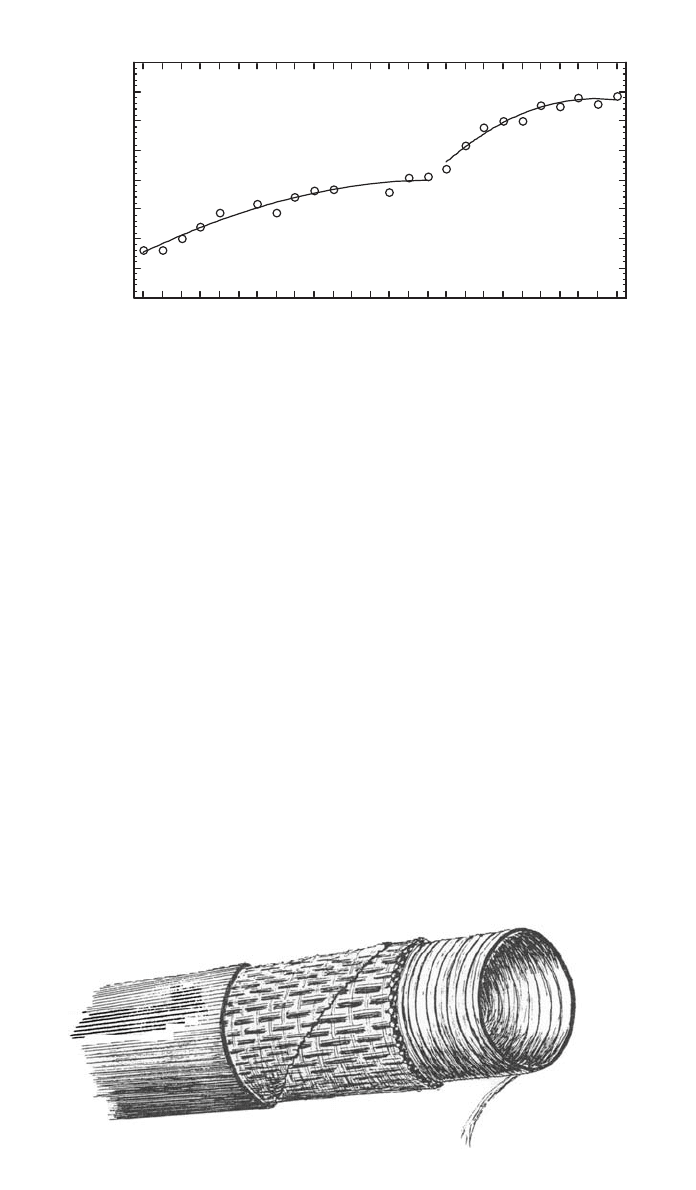
1260 ADVANCED MATERIALS IN SPORTS EQUIPMENT
2.5
3.0
3.5
4.0
4.5
5.0
5.5
6.0
6.5
Pole vault height jumped (m)
1896
1900
1904
1908
1912
1916
1920
1924
1928
1932
1936
1940
1944
1948
1952
1956
1960
1964
1968
1972
1976
1980
1984
1988
1992
1996
Fig. 7 Winning heights in pole vaults since first Olympic event.
Longitudinal carbon fibers/epoxy
Glass fiber web/epoxy
Rings of glass fibers
Fig. 8 Adding in minimal twisting requirement, carbon fiber composite becomes more attrac-
tive with three layers of different fibers being used to optimize the performance. (From Ref. 2.)
turning upside-down and gliding over the bar feet first. Improvements in tech-
nique using the new pole once again lead to increases in performance that are
only just beginning to slow down.
If we refer to Table 1, and also add the requirement of durability, the material
of choice is the carbon fiber composite, with bamboo not too far behind. If we
add in the minimal twisting requirement, the carbon fiber composite becomes
even more attractive (Fig. 8) with three layers of different fibers being used to
optimize the performance. An outer layer of high-strength carbon fiber provides
high stiffness, while an intermediate webbing of fibers together with an inner
layer of wound glass fiber, builds in resistance to twisting. The glass fiber con-
sists of 80% longitudinal and 20% radial fibers. So for the pole vault advanced
materials have a major influence on performance.
3.3 Bicycling
Cycling is a highly efficient form of transportation, with the energy consumption
lower than for walkers, and much lower than for powered vehicles.
2,7,8
The
Chinese, recognizing this, build over 10 million bicycles per year. The bicycle
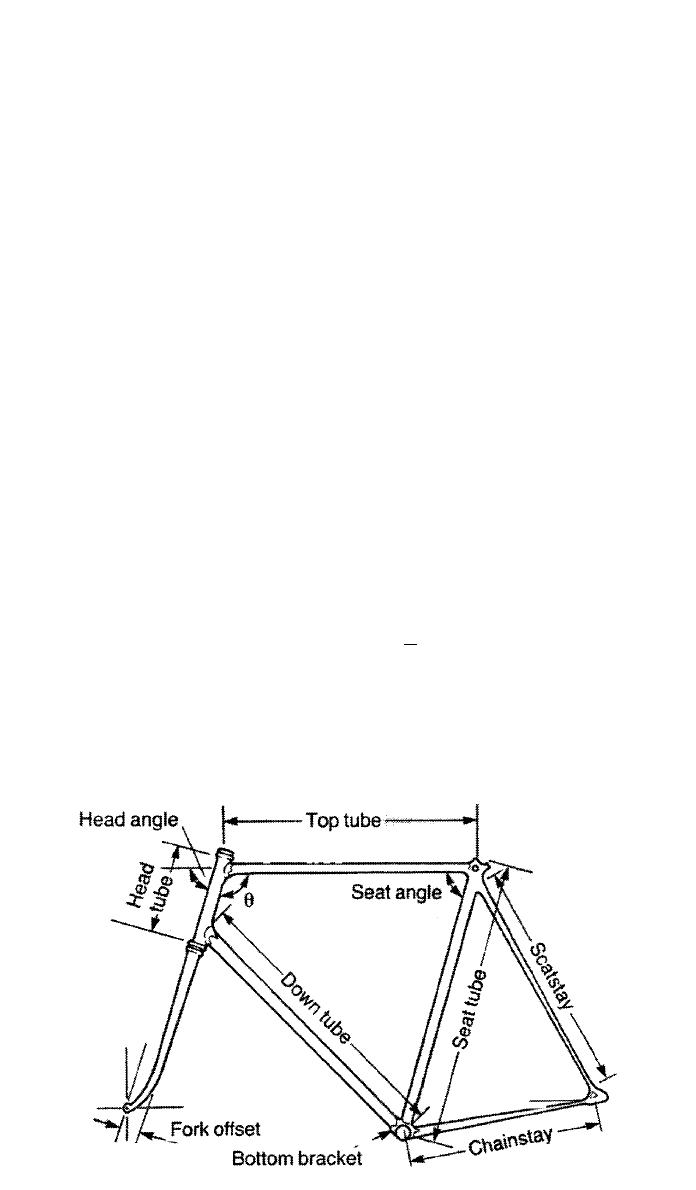
3 THE IMPACT OF ADVANCED MATERIALS ON SPORTS PERFORMANCE 1261
Fig. 9 Bicycle diamond frame. (From Ref. 2.)
has been around for almost 200 years maturing from the 1817 Draisienne (walk-
ing device) to the modern-day Rover Safety Bicycle designed by J. K. Starley
in 1885. Nowadays, advanced materials, in combination with aerodynamic con-
siderations, have led to vastly improved bicycles. When Greg LeMond won the
1989 Tour de France (3420 km) by only 8 s, for example, his success was made
possible by a clip-on extension of his handlebars with a padded tube, which
enhanced his aerodynamic shape.
The bicycle can be considered to be a modified ‘‘space frame’’ such as that
found in bridges, cranes, etc. For the bicycle this is the ‘‘diamond frame’’ (Fig.
9).
A number of advances have contributed to the high efficiency of a modern-
day bicycle including the development of spoke wheels, the chain concept, pneu-
matic tires, and such accessories as seats, brake levers, and pedals. The two
major advances are in the frame and wheels, however, and we will now consider
these two components of the advanced bicycle.
Frame
The diamond frame and the alternate structure, the ‘‘cross frame,’’ are both
constructed from thin-walled tubular components that must resist tension, com-
pression, bending, and torsional stresses. The requirements for the materials of
construction of a bicycle are shown in Table 4.
These materials requirements can be simplified to the minimization of the
bending of a cantilever beam; then the mass is given by
M ⫽ const ⫻
E
Thus the optimum material is the material with the highest specific strength
/E. Based upon the data shown in Table 1, carbon fiber composites are the
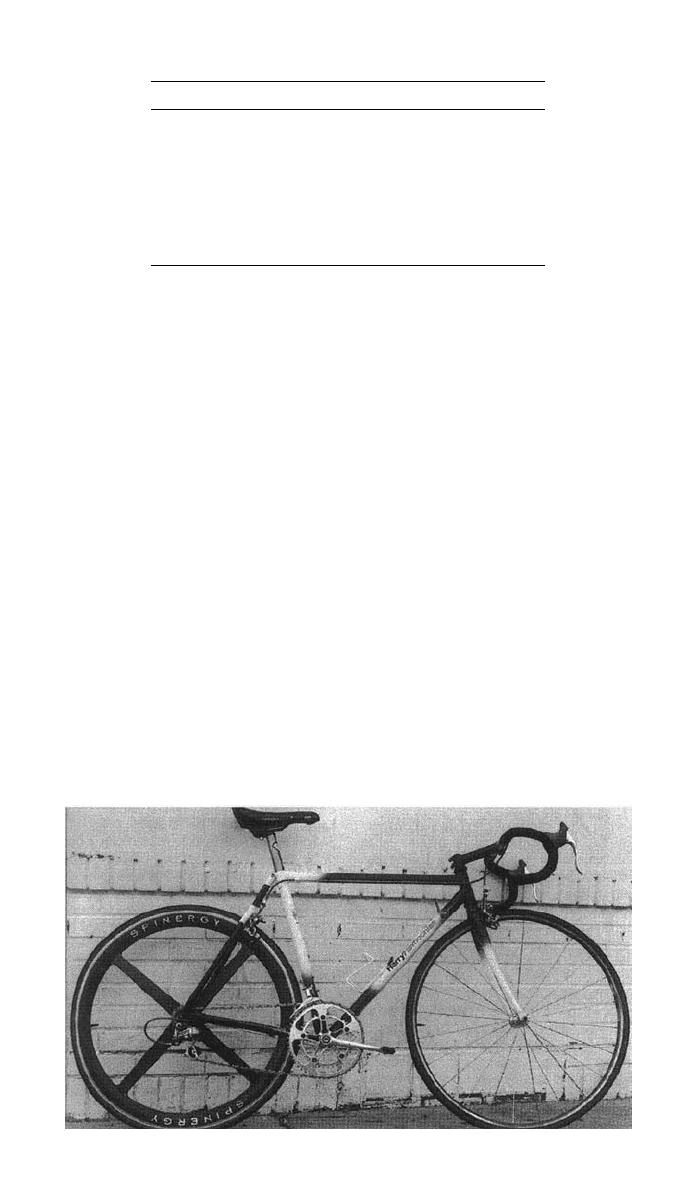
1262 ADVANCED MATERIALS IN SPORTS EQUIPMENT
Table 4 Materials Requirements for a Bicycle and
Possible Materials of Choice
Requirements Possible Materials of Choice
Light (low density) Carbon fiber composites
Stiff Aluminum
Strong Titanium
Toughness Magnesium
Fatigue resistance Steel
Corrosion resistance
Cost
Metal matrix composites
Fig. 10 Road bicycle made by Harry Havnoonian with a mix of materials using adhesive bond-
ing for joints, investment-cast stainless steel lugs, Ti-3Al-2.5V head tube, SiC-fiber-reinforced
aluminum alloy front triangle, CRFP rear triangle, and CFRP rear wheel.
materials of choice if there is no concern over cost. Lightweight metals—
aluminum, magnesium and titanium—are also attractive, as are metal matrix
composites (Fig. 10
9
). If cost is a concern, then steel, which is not that far behind
the other materials, is the obvious material for selection.
In addition to the carbon fiber reinforced composite frames, recently frames
have been produced from magnesium, aluminum, titanium and metal matrix
composites. In addition hybrid frames such as carbon fiber reinforced composite
combined with titanium have been produced.
Wheels
Advances here include wheels with increased stability and rigidity for off-road
bikes constructed from glass fiber reinforced nylon, and disc wheels. In the latter
concept discs made of aluminum alloys or carbon fiber reinforced composites
replace the spokes in conventional wheels. Developments also include three or
five spoke wheels for rigidity and crosswind aerodynamics.
The improvements that advanced materials have produced in bicycling can
be gauged in the enhancement in the Olympic pursuit records shown in Table
5.
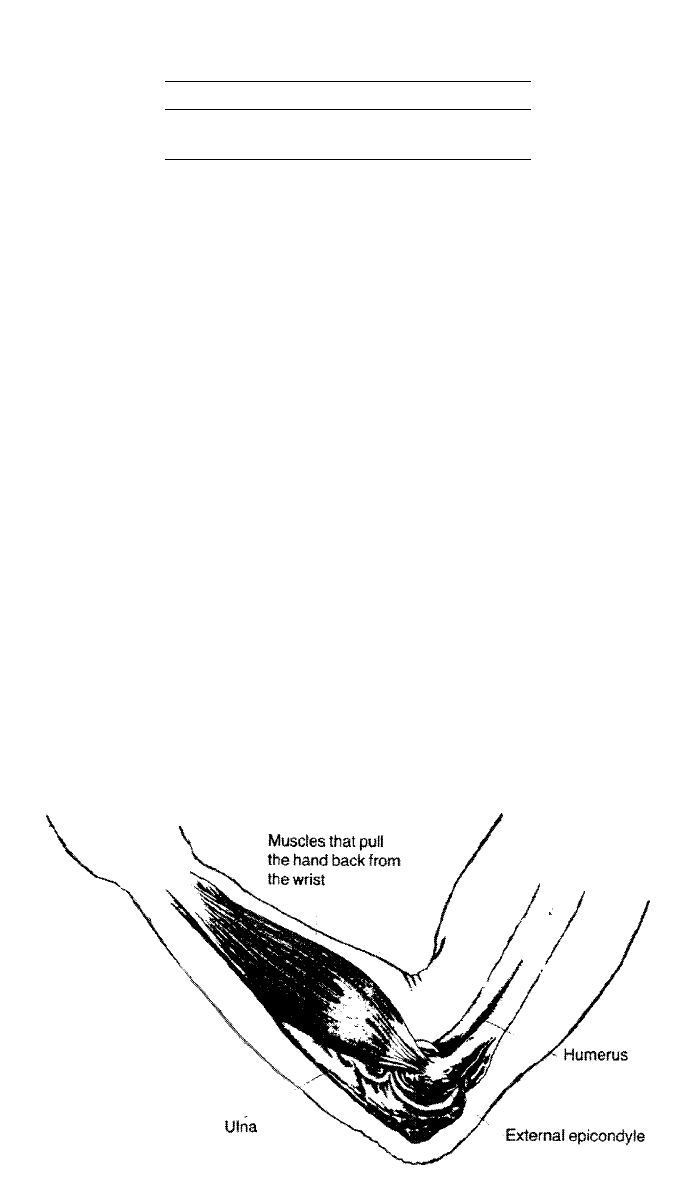
3 THE IMPACT OF ADVANCED MATERIALS ON SPORTS PERFORMANCE 1263
Table 5 Improvement in Olympic Records for
the Bicycle 4000-m Individual Pursuit
Competitor Year Time
Daler (CZE) 1964 5 min 5 s
Boardman (GB) 1992 3 min 22 s
Fig. 11 Dangerous vibration can lead to tennis elbow. (From Ref. 2.)
3.4 Tennis and Squash
Tennis is a sport in which absolute achievements cannot be compared. Who can
argue with the notion that Bobby Riggs with his 1939 wooden racket would
have no chance against Pete Sampras armed with an oversized composite racket
with an enlarged ‘‘sweet spot.’’ In fact, this confrontation has been framed as
‘‘like fighting against rifles with bows and arrows.’’
10
Until about 25 years ago, tennis rackets were made from wood with ash,
maple, and okume leading the way. In the late 1960s metal frames, generally
fabricated from steel or aluminum, were introduced. At the present time, com-
posite rackets are all the rage, not only from the viewpoint of efficiently accel-
erating the ball across the net, but also in terms of damping dangerous vibration,
which can lead to ‘‘tennis elbow’’ (Fig. 11).
The impact force experienced by a player on returning a tennis ball traveling
at 160 km per hour (100 mph) is approximately equivalent to jerk-lifting a
weight of about 75 kg (170 lb). These forces can transmit a high load to the
lateral epicondyle, located on the outer side of the elbow; leading to damage to
the small blood capillaries in the muscles and tendons around the elbow joint.
Better technique can help, but improved rackets can also make a major contri-
bution.
The goal in designing modern tennis rackets is to increase the size of the
sweet spot, the central part of the racket, which leads to little or no shock to
the player and minimal vibration occurs upon impact with the ball. This depends

1264 ADVANCED MATERIALS IN SPORTS EQUIPMENT
upon the stiffness of the frame and the size and shape of the handle and head.
The International Tennis Federation have now imposed an upper limit to the size
of the racket.
Today tennis rackets are produced from monolithic metals, including steel,
aluminum, magnesium, and titanium and metal matrix composites. However, the
high stiffness of carbon-fiber-reinforced composites makes them superior to the
metals in imparting high forces to the ball. To reduce the high-frequency vibra-
tion upon impact, racket handles are constructed of multiple fiber-reinforced
layers wrapped around a soft inner core, which is often an injected polyurethane
foam or honeycomb construction.
An example of a state-of-the-art tennis racket is the Wilson FPK, which con-
sists of a urethane core, 84% graphite, 12% Kevlar, and 4% fiber FP (a pure
form of ceramic aluminum oxide). The graphite provides strength and stiffness,
thereby minimizing head deflection and helps to prevent twisting of the racket
head when the ball impacts outside the sweet spot. The Kevlar fibers lead to
additional strength and durability and contribute to damping vibration. The fiber
FP produces even greater stiffness and damping to this type of tennis racket.
Squash rackets have shown similar trends to tennis rackets.
2
Until 1983, the
frame was constructed of wood. Since then, squash rackets have featured hollow
extruded aluminum designs and fiber-reinforced plastics, the latter featuring
lightness, strength, toughness, and reduced vibration.
Racket strings have transitioned from ox gut to the modern-day synthetic (e.g.,
nylon) strings. This transition has not been without controversy. In the late
1970s, so-called spaghetti stringing, which resulted in large amounts of spin
being imparted to the ball and an unpredictable bounces, led to a rule requiring
‘‘strings to be interlaced and attachments for durability purposes only, not de-
signed to alter the flight in the ball.’’
11,12
Wheelchairs (Fig. 12) now allow the paraplegic athlete to compete in this
sport, as well as others, including racing events, basketball, and rugby. No heavy
steel frames here—rather bikelike wheels, use of aerospace carbon fibers, and
titanium, as well as computer-aided design of the suspension. Now there is a
chair for each sport: basketball, racing, and even tennis. For example, tennis
chairs are built with sharply slanted back wheels so the athlete can move quickly
from side to side. In basketball, forwards have high seats, guards have more
slant in their chairs in order to turn quickly. Cost? Top wheelchairs are in the
range of $2000–$3300 apiece.
3.5 Cricket
As with tennis rackets, the manufacturers of cricket bats have been concerned
with the size of the sweet spot and the reduction of flexural vibrations.
13
Three
significant modes of flexural vibrations detract from the ideal rigid-body per-
formance, and whereas distributing the weight of the blade to the edges (perim-
eter weighting) does not increase modal frequencies significantly, it may increase
the width of the sweet spot.
3.6 Golf
Paralleling the tennis situation, it is very difficult to compare many of the
achievements of the past with those of today in absolute terms. Clubs have

3 THE IMPACT OF ADVANCED MATERIALS ON SPORTS PERFORMANCE 1265
Fig. 12 Steve Meredith of Titanium Sports of Kennewick, WA (left) along with Alistair Godfrey
and Malcolm Ward-Close of the Defense Evaluation and Research Agency (DERA), United King-
dom, are shown inspecting a titanium wheel chair.
evolved tremendously and it is difficult to imagine that Bobby Jones, using
hickory shafts, could compete, at least in length, with Tiger Woods, Ernie Els,
or David Duval armed with a shaft constructed from a graphite-epoxy and an
over-sized hollow titanium head; albeit at a high price.
The materials evolution for the driver is dramatic. The overall weight has
been decreased and the length of the club increased from 100 cm to as much
as 125 cm. The grip and shaft weight has been reduced from 165 grams down
to 115 grams or less. The weight of the head remains the same at about 200 g
but using a hollow titanium (casting) construction, the head is now much bigger,
with the mass concentrated around the outside of the hitting face. The net result
is a club that is claimed to give greater distance (greater club head speed because
of the longer arc) but also a straighter (bigger sweet spot) shot.
A concern of the U.S. Amateur Golf Association (USGA) is that technology
may dominate over skill, i.e., no ‘‘spring-back’’ (trampoline) effect should occur
when the ball is struck by the clubface, which may add distance. When a golf
ball hits any surface it rebounds at a velocity less than that at which it hit the
surface (Physics 101).
14
Materials with a high elasticity and high strength result
in a high rebound velocity (or high coefficient of restitution [COR]), especially

1266 ADVANCED MATERIALS IN SPORTS EQUIPMENT
when the impacted surface is thin (allowing the ‘‘trampoline’’ effect). Thus the
hitting surface can be tuned to increase the COR. However, this now puts us on
the ragged edge of the mechanical property limits of materials of construction.
Thus you will hear of the ‘‘proprietary heat treatments’’ (simply an aging treat-
ment to increase the strength) to create a beta titanium alloy that is strong and
capable of resisting fracture (most of the time) even though it is thinner than
conventional titanium (e.g., Ti–6Al–4V) hitting faces.
With a tuned (nonconforming) face, the COR will exceed the USGA limit of
0.83 (somewhat arbitrarily set to allow the majority of the drivers at the time
the limit was set to meet the requirement). However, the salient question is: Do
the nonconforming drivers actually lead to increased distance? Tests by Golf
Digest
14
indicated that the trampoline effect is maximized only in a relatively
small area of the clubface. This means that it requires the impact accuracy of a
robot or a professional to take full advantage of the effect. This has been con-
firmed in robot testing of a nonconforming club head (COR 0.845) where a 2%
increase in ball speed (over a confirming club with a COR of 0.81) increased
carry distance by 1–2 yards for 220 yards shots and 4–6 yards for 270-yard
drives (the higher the swing speed, the greater the increase in ball speed and
therefore, carry distance). And to the crux of the matter: 40 players (0 to 22
handicap) had essentially the same distance from both the conforming and non-
conforming clubs. Worse: With off-center hits, there are indications that the
nonconforming club hits the ball shorter distances than the confirming club.
The USGA fears that ‘‘trampoline’’ clubs and other ‘‘out there’’ technologies
could add 30 yards to a drive.
15
With a perfect center hit, a COR of 0.880/0.900
(the maximum likely) and a 109-mph swing (a pro’s swing), the distance gap
between a persimmon wood (COR 0.77) is about 25 yards.
15
So potentially a
maximum of another 25 yards is possible with a nonconforming driver (COR
0.880/0.900) with an optimally struck approved golf ball. Thus there is a legit-
imate concern with the professionals, probably none for the average golfer.
Driving distance is an absolute criterion, which can be tracked versus the
material of construction, with a caveat that the modern top golfers on the PGA
tour now realize that exercise and body-building help their performance, far from
a common practice in the past. The average PGA tour driving distance is shown
in Fig. 13,
15
with a spike in 1994 at the time of the introduction of the titanium
driver. A complication here is that balls have also evolved tremendously, with
the most lively being banned because they would obsolete current golf courses.
3.7 Baseball/Softball
Aluminum baseball bats are banned in the U.S. major leagues because they
would make current baseball stadiums obsolete. There would be too many home
runs. However, both new aluminum bat concepts such as the ultralight, with a
double-walled barrel construction, and titanium bats are revolutionizing softball.
These bats have bigger sweet spots and lead to greater velocity off the bat.
However, the Softball Association is concerned with an increase in injuries to
infielders who cannot react quickly enough to this higher velocity. An example
of a softball bat produced from titanium using a powder metallurgy approach is
shown in Fig. 14.

3 THE IMPACT OF ADVANCED MATERIALS ON SPORTS PERFORMANCE 1267
Fig. 13 Average driving distance on the PGA tour. Note spike since the introduction
of the titanium driver in 1994.
Fig. 14 Susan Abkowitz of Dynamet Technology, Inc. holds a softball bat
with a titanium alloy outer shell.
3.8 Boats, Boards, and Wind-Surfing Fins
For all watercraft, there are four basic forces to contend with when considering
design: weight, lift, thrust, and drag (Fig. 15).
2
Materials of construction are
needed that result in lightweight, low skin friction (to give smooth flow and
reduced drag), increased toughness and a high level of safety. Modern craft
consist of a combination of several polymeric composite materials, often incor-
porating cellular (sandwich) concepts.
The construction of a wind-surfing board is complex consisting of a core of
extruded foam polyestrene filler enclosed in fiberglass. This core is covered
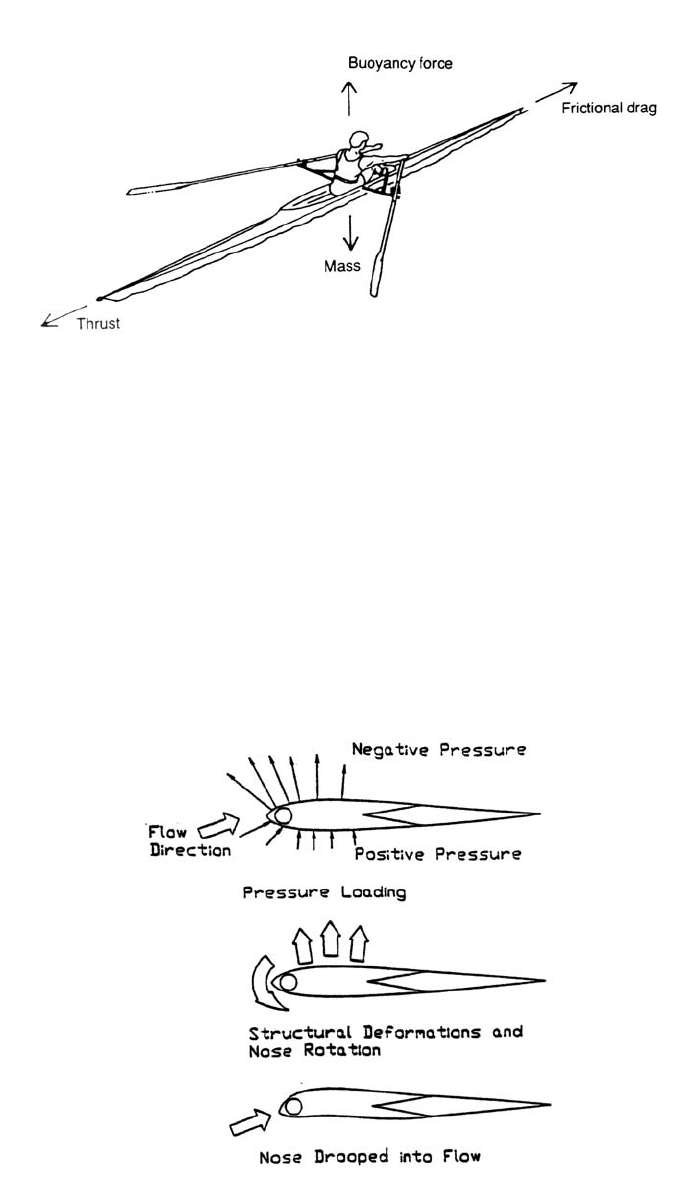
1268 ADVANCED MATERIALS IN SPORTS EQUIPMENT
Fig. 15 Forces acting on a watercraft.
Fig. 16 Method of operation of hydroelastically tailored wind-surfing fin.
with graphite and glass fibers embedded in resin matrices, with an outer surface
of glass-fiber-reinforced composite.
An interesting materials application involves the design of the wind-surfing
fin. The challenge is to design a fin with optimal hydrodynamic shape because
surfers need to perform equally in both directions, requiring a symmetric design.
Innovation relied on a concept known as hydroelastic tailoring.
16
Through this
process, structural deformation of the cross sections (Fig. 16) is induced by the
hydrodynamic–pressure forces, with the internal structure encased in a flexible
elastomer material covering. As this section moves through the water (at an
incidence angle), a surface pressure loading results, as shown. This surface pres-
sure loading is of insufficient magnitude to deform the supporting internal struc-
